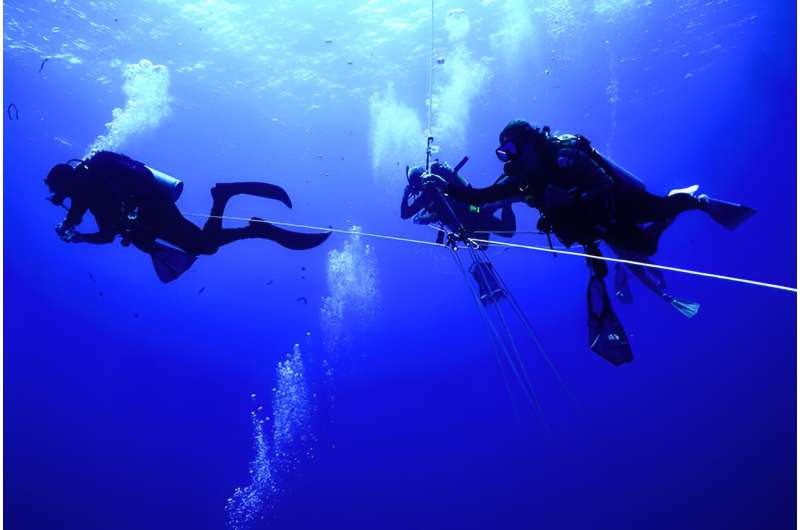A collage of the five species of comb jelly studied. Red coloration, as seen in the two specimens on the right, is common in deep-sea animals. Credit: 2021 Jacob Winnikoff
The ocean floor is not hospitable. There is no light; the temperature is freezing; and the pressure of all the water above will literally crush you. Animals that live at this depth have developed biophysical adaptations that allow them to survive in these harsh conditions. What are these adjustments and how did they evolve?
UC San Diego assistant professor of chemistry and biochemistry Itay Budin teamed up with researchers across the country to study the cell membranes of ctenophores (“comb jellies”) and discovered that they have unique lipid structures that allow them to live under intense pressure. Their work appears in Science.
Adaptation to the environment
First: although comb jellies look like jellyfish, they are not closely related. Comb jellies comprise the phylum Ctenophora (pronounced tee-no-for-a). They are predators that can grow up to the size of a volleyball and live in oceans around the world and at various depths, from the surface to the deep sea.
Cell membranes have thin layers of lipids and proteins that need to maintain certain properties for cells to function properly. Although it has been known for decades that some organisms have adapted their lipids to maintain fluidity in extreme cold – a so-called homeoviscous adaptation – it was not known how organisms living in the deep sea adapted to extreme pressure, or whether the adaptation to pressure was equally as an adaptation to the cold.
Budin studied homeoviscous adaptation in E. coli bacteria, but when Steven Haddock, a senior scientist at the Monterey Bay Aquarium Research Institute (MBARI), asked if ctenophores had the same homeoviscous adaptation to compensate for extreme pressure, Budin was intrigued.
Complex organisms have different types of lipids. Humans have thousands of them: the heart is different from the lungs, which are different from those in the skin, and so on. They also have different shapes; some are cylindrical and some are cone shaped.
To answer whether ctenophores adapted to cold and pressure by the same mechanism, the team needed to control the temperature variable. Jacob Winnikoff, lead author of the study, who worked at both MBARI and UC San Diego, analyzed ctenophores collected from across the Northern Hemisphere, including those that lived on the ocean floor in California (cold, high pressure) and those from the surface of the Arctic Ocean (cold, not high pressure).

Diving for comb jellies in shallow water off the Big Island of Hawaii. Most comb jellies live in the open ocean, where divers must use ropes to avoid drifting. Credit: 2021 Jacob Winnikoff
“It turns out that ctenophores have evolved unique lipid structures to compensate for intense pressure that are separate from those that compensate for intense cold,” Budin said, “so much so that pressure is actually what holds their cell membranes together.”
Scientists call this adaptation “homeocurvature” because the curve-forming shape of lipids has adapted to the unique environment of ctenophores. In the deep sea, cone-shaped lipids evolved into exaggerated cone shapes. The pressure of the ocean counteracts the exaggeration, so the shape of the lipids is normal, but only at these extreme pressures. When deep-sea ctenophores come to the surface, the exaggerated cone shape returns, the membranes separate, and the animals disintegrate.
Molecules with an exaggerated cone shape are a type of phospholipids called plasmogens. Plasmalogens are abundant in the human brain, and their decline often accompanies declining brain function and even neurodegenerative diseases such as Alzheimer’s disease. This makes them of great interest to scientists and medical researchers.
“One of the reasons we chose to study ctenophores is that their lipid metabolism is similar to humans,” Budin said. “And while I wasn’t surprised to find plasmalogens, I was shocked to see that they made up as much as three-quarters of the lipid content of a deep-sea ctenophore.”
To further test this discovery, the team returned to E. coli and performed two experiments in high-pressure chambers: one with unaltered bacteria and the other with bacteria that had been bioengineered to synthesize plasmalogens. While the unmodified E. coli died out, the strain of E. coli containing the plasmogens thrived.
These experiments were carried out over several years and with collaborators from different institutions and disciplines. At UC San Diego, in addition to Budin, whose group performed biophysical and microbiological experiments, the laboratory of Distinguished Professor of Chemistry and Biochemistry Edward Dennis performed mass spectrometry analysis of lipids. Marine biologists at MBARI collected the ctenophores for study, while physicists at the University of Delaware ran computer simulations to verify the behavior of the membranes at different pressures.
Budin, who is interested in studying how cells regulate lipid production, hopes the discovery will lead to further investigation of the role of plasmogens in brain health and disease.
“I think the research shows that plasmagens have really unique biophysical properties,” he said. “So now the question is, how are these properties important to the function of our own cells? I think that’s one message.”
More information:
Jacob R. Winnikoff et al, Homeocurvature adaptation of phospholipids to pressure in deep-sea invertebrates, Science (2024). DOI: 10.1126/science.adm7607
Provided by University of California – San Diego
Citation: Under Pressure: How Comb Jellies Adapted to Life on the Ocean Floor (2024, June 27) Retrieved June 28, 2024, from https://phys.org/news/2024-06-pressure-jellies-life-bottom-ocean. html
This document is subject to copyright. Except for any bona fide act for the purpose of private study or research, no part may be reproduced without written permission. The content is provided for informational purposes only.